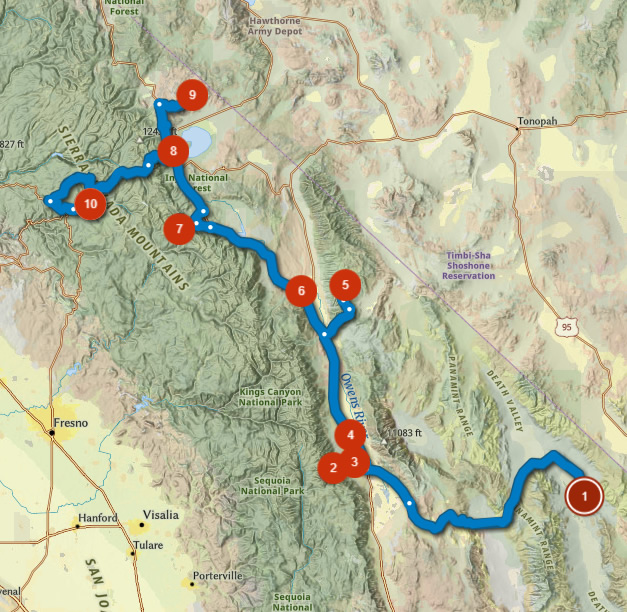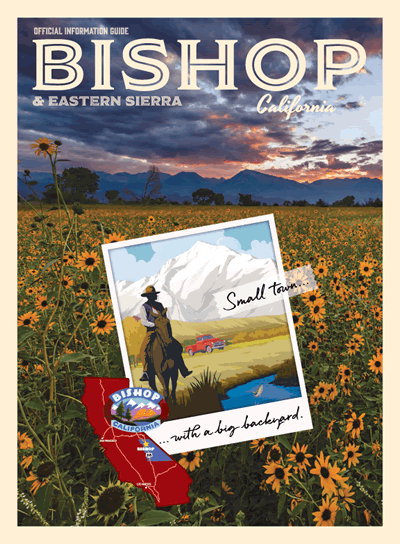BISHOP AND THE OWENS VALLEY
The City of Bishop in Inyo County, California was named for one of the first white settlers in the area, Samuel A. Bishop. Owens Lake was named for Richard Owens, a member of John C. Fremont’s 1845 exploration party which included Kit Carson and Ed Kern. Later the entire valley became known as The Owens Valley (see First Settlers below). The Paiute Indians called Owens Lake by the name of “Pacheta” and the Owens River “Wakopee.” In size, Inyo County is today the second largest county in California with a population of slightly over 18,000 residents. The county is so big that several eastern states put together would fit neatly within its boundaries. Inyo County contains both the highest and lowest points in the contiguous United States; Mt. Whitney, 14,505 feet above sea level, and Badwater in Death Valley, -282 feet below sea level. A difference of nearly 15,000 feet. The “Inyo” in Inyo County is commonly believed to be a Paiute word meaning “dwelling place of the great spirit,” although some scholars are now convinced that it is a mistranslation of the word, “Indio,” Spanish for Indian. It is possible that the Paiute were trying to explain to the earliest English speaking settlers in the Owens Valley that this was their land by using a form of “Indio” they had learned from other Indian tribes, who in turn, had learned it from the Spanish or Mexicans, not realizing that not all white men spoke the same language. Thus Inyo may actually mean “Indian Land.”
Introduction by Mike Cheuvront
FIRST SETTLERS
The first white American explorers in the Owens Valley of Eastern California included the famous mountain men Jedediah Smith in 1826 and Joseph Walker in 1834. This remote area of California had never been explored by the Spanish and even though it was shown as Mexican territory on early maps, the Eastern Sierra region remained unvisited by them. Present-day Walker Lake in western Nevada, the Walker River on the California/Nevada border and Walker Pass in the southern Sierra were named for their discoverer, Joseph Walker.
The most renowned early explorer to visit the area was John C. Fremont. He was the first Republican candidate to run for President of the United States in 1856 and later a famous Union Civil War general. Officially sanctioned by the federal government, his 1845 mapping party to the Eastern Sierra included the celebrated Indian scout Kit Carson, for whom the capitol of Nevada, Carson City, was named. Also in the party were Ed Kern for whom Kern County, California was named, and Richard Owens, who gave his name to the Owens Lake near Lone Pine and later the Owens Valley itself. Fremont lost a cannon that he had brought along in case of Indian attacks somewhere near present-day Bridgeport, California (about 80 miles north of Bishop). Perhaps someone will stumble across the rusty old cannon someday.
The City of Bishop came into being due to the need for beef in a booming mining camp some eighty miles to the north, Aurora , Nevada, (Aurora was believed to be on the California side of the border at that time and was the county seat of Mono County, California). In 1861 cattlemen drove herds of cattle some three hundred miles from the great San Joaquin Valley of California, through the southern Sierra at Walker Pass, up the Owens Valley, and then through Adobe Meadows to Aurora. Along the way, some cattlemen noticed that the unsettled northern Owens Valley was perfect for raising livestock.
To avoid the long journey from the other side of the mountains, a few of them decided to settle in the valley. Driving some 600 head of cattle and 50 horses, Samuel Addison Bishop, his wife, and several hired hands arrived in the Owens Valley on August 22, 1861 from Fort Tejón in the Tehachapi Mountains. Along with Henry Vansickle, Charles Putnam, Allen Van Fleet, and the McGee brothers, Bishop was one of the very first white settlers in the valley.
The cattlemen were soon followed by sheepmen who initially struggled with a lack of forage for their stock in the area. Remnants of these early settler’s stone corrals and fences can still be seen north of Bishop along Highway 395 in Round Valley (barb wire fencing was not invented until 1873). Establishing a homestead, the San Francis Ranch, along the creek which still bears his name, Samuel Bishop set up a market to sell beef to the miners and business owners in Aurora .
One of the residents of Aurora at that time was a young Samuel Clemens who later gained fame as author Mark Twain (see Twain’s Roughing It for his comments on our area).
By 1862, a frontier settlement (and later town), known as Bishop Creek, was established a couple of miles east of the San Francis Ranch. Though the town continues to prosper, the only reminder of Samuel Bishop’s ranch today is a monument placed near the original site at the corner of Highway 168 West and Red Hill Road, two miles west of downtown Bishop.
In 1866, the County of Inyo was established from part of Tulare County. The Eastern High Sierra and the Owens Valley was the westernmost frontier in America at that time. In 1871, Daniel Bruhn was one of 41 wranglers herding some 3000 wild Spanish mustangs from Stockton, California to Texas. Their travels took them over the High Sierra and into the remote Owens Valley where they lost over 500 head of horses. The descendants of those mustangs still roam wild on the California/Nevada border just north of Bishop.
WATER CONFLICTS IN THE OWENS VALLEY
Between 1905 and 1907 most of the land in the Owens Valley was purchased from farmers and ranchers at bargain prices by William Mulholland, superintendent of the Water Department for the City of Los Angeles under the guise of a local irrigation project. Their real goal was to send Owens Valley water south to Los Angeles. By the time the now famous Los Angeles Aqueduct was completed in 1913, it was too late for valley residents to take any action.
The aqueduct, 223 miles long, used no pumping stations just gravity siphons sending water from the Owens Valley to Southern California. The City of Los Angeles receives 70% of its water from the Owens Valley and the Eastern High Sierra. With the diversion of water to Los Angeles, the Owens Lake and lower Owens River dried up and many valley residents were forced to pack up and leave the area forever. For a number of years, Owens Valley residents expressed much animosity toward the City of Los Angeles as can be seen in Dry Ditches, a little book of poems published in 1934 by the Parcher family of Bishop. The Owens Valley-City of Los Angeles conflict was the inspiration of the 1974 film Chinatown, starring Jack Nicholson.
Today the Los Angeles Department of Water and Power (LADWP) is a good steward of the land and offers visitors and locals alike many recreational opportunities including fishing, hunting and recreating on city owned property. The LADWP allows unrestricted access to most of its lands (no camping except in designated campgrounds) and the stretch of the Owens River in the valley is open to fishing year around.
NATIVE AMERICAN CULTURAL HERITAGE
Years ago in this broad and beautiful valley, now called the Owens Valley, bordered by the Sierra Nevada Mountains to the west and the White and Inyo ranges on the east, lived a people who were observant, resourceful and practical. They lived from what the land could provide. All of their needs – food, clothing, housing, medicine, arts and entertainment – were satisfied by their efforts at hunting and gathering. In all seasons the land gave up to them what they needed. Today these people are known by the names given by scholars to their languages – Paiute and Shoshone. They now reside on four Reservations in the Owens Valley . The southernmost is the Lone Pine Indian Reservation, northward is Fort Independence Reservation and Big Pine Indian Reservation. The largest and northernmost is the Bishop Indian Reservation.
MUSEUMS OF OWENS VALLEY
For more information on the museums of the Owens Valley, visit our Museums Page.




